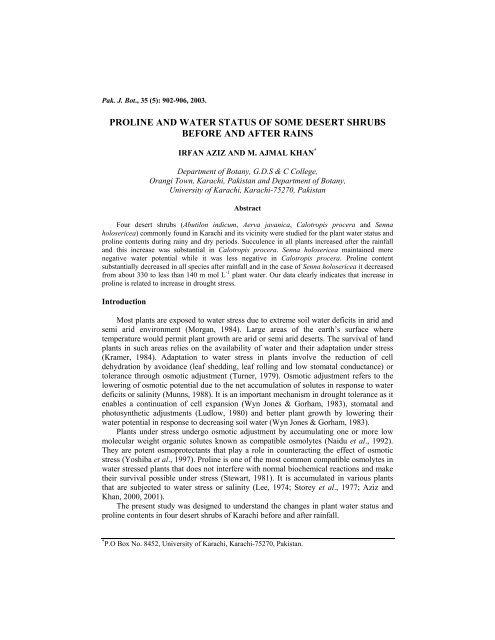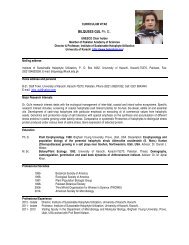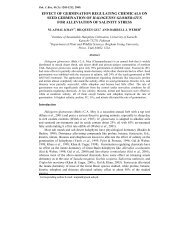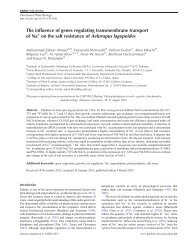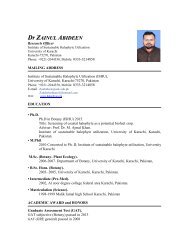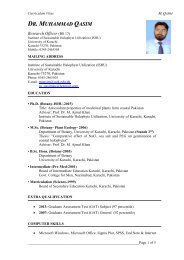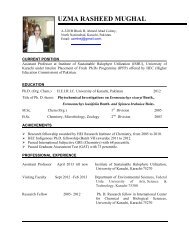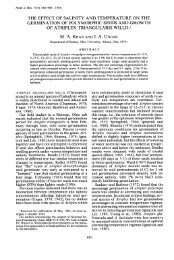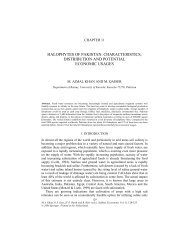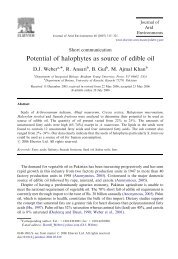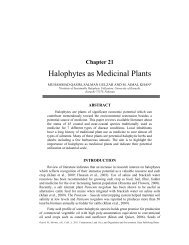proline and water status of some desert shrubs ... - ResearchGate
proline and water status of some desert shrubs ... - ResearchGate
proline and water status of some desert shrubs ... - ResearchGate
You also want an ePaper? Increase the reach of your titles
YUMPU automatically turns print PDFs into web optimized ePapers that Google loves.
Pak. J. Bot., 35 (5): 902-906, 2003.<br />
PROLINE AND WATER STATUS OF SOME DESERT SHRUBS<br />
BEFORE AND AFTER RAINS<br />
IRFAN AZIZ AND M. AJMAL KHAN *<br />
Department <strong>of</strong> Botany, G.D.S & C College,<br />
Orangi Town, Karachi, Pakistan <strong>and</strong> Department <strong>of</strong> Botany,<br />
University <strong>of</strong> Karachi, Karachi-75270, Pakistan<br />
Abstract<br />
Four <strong>desert</strong> <strong>shrubs</strong> (Abutilon indicum, Aerva javanica, Calotropis procera <strong>and</strong> Senna<br />
holosericea) commonly found in Karachi <strong>and</strong> its vicinity were studied for the plant <strong>water</strong> <strong>status</strong> <strong>and</strong><br />
<strong>proline</strong> contents during rainy <strong>and</strong> dry periods. Succulence in all plants increased after the rainfall<br />
<strong>and</strong> this increase was substantial in Calotropis procera. Senna holosericea maintained more<br />
negative <strong>water</strong> potential while it was less negative in Calotropis procera. Proline content<br />
substantially decreased in all species after rainfall <strong>and</strong> in the case <strong>of</strong> Senna holosericea it decreased<br />
from about 330 to less than 140 m mol L -1 plant <strong>water</strong>. Our data clearly indicates that increase in<br />
<strong>proline</strong> is related to increase in drought stress.<br />
Introduction<br />
Most plants are exposed to <strong>water</strong> stress due to extreme soil <strong>water</strong> deficits in arid <strong>and</strong><br />
semi arid environment (Morgan, 1984). Large areas <strong>of</strong> the earth’s surface where<br />
temperature would permit plant growth are arid or semi arid <strong>desert</strong>s. The survival <strong>of</strong> l<strong>and</strong><br />
plants in such areas relies on the availability <strong>of</strong> <strong>water</strong> <strong>and</strong> their adaptation under stress<br />
(Kramer, 1984). Adaptation to <strong>water</strong> stress in plants involve the reduction <strong>of</strong> cell<br />
dehydration by avoidance (leaf shedding, leaf rolling <strong>and</strong> low stomatal conductance) or<br />
tolerance through osmotic adjustment (Turner, 1979). Osmotic adjustment refers to the<br />
lowering <strong>of</strong> osmotic potential due to the net accumulation <strong>of</strong> solutes in response to <strong>water</strong><br />
deficits or salinity (Munns, 1988). It is an important mechanism in drought tolerance as it<br />
enables a continuation <strong>of</strong> cell expansion (Wyn Jones & Gorham, 1983), stomatal <strong>and</strong><br />
photosynthetic adjustments (Ludlow, 1980) <strong>and</strong> better plant growth by lowering their<br />
<strong>water</strong> potential in response to decreasing soil <strong>water</strong> (Wyn Jones & Gorham, 1983).<br />
Plants under stress undergo osmotic adjustment by accumulating one or more low<br />
molecular weight organic solutes known as compatible osmolytes (Naidu et al., 1992).<br />
They are potent osmoprotectants that play a role in counteracting the effect <strong>of</strong> osmotic<br />
stress (Yoshiba et al., 1997). Proline is one <strong>of</strong> the most common compatible osmolytes in<br />
<strong>water</strong> stressed plants that does not interfere with normal biochemical reactions <strong>and</strong> make<br />
their survival possible under stress (Stewart, 1981). It is accumulated in various plants<br />
that are subjected to <strong>water</strong> stress or salinity (Lee, 1974; Storey et al., 1977; Aziz <strong>and</strong><br />
Khan, 2000, 2001).<br />
The present study was designed to underst<strong>and</strong> the changes in plant <strong>water</strong> <strong>status</strong> <strong>and</strong><br />
<strong>proline</strong> contents in four <strong>desert</strong> <strong>shrubs</strong> <strong>of</strong> Karachi before <strong>and</strong> after rainfall.<br />
* P.O Box No. 8452, University <strong>of</strong> Karachi, Karachi-75270, Pakistan.
903<br />
Table 1. Results <strong>of</strong> two- way ANOVA <strong>of</strong> characteristics in leaves by<br />
plant species (P) <strong>and</strong> seasons (S).<br />
Independent variable P S P x S<br />
Water potential 42.7* 68.1** 23.1*<br />
Proline 32.7* 67.5*** 61.3**<br />
Leaf succulence 133.9*** 84.1** 27.2*<br />
Note: Numbers represent F-values. * = P < 0.05; ** = P < 0.01; *** = P < 0.001.<br />
Water Potential (-MPa)<br />
4<br />
3<br />
2<br />
1<br />
a<br />
Young<br />
Old<br />
b<br />
(Before Rain)<br />
AI = Abutilon indicum (After Rain)<br />
AJ = Aerva javanica<br />
CP = Calotropis procera<br />
SH = Senna holosericea<br />
c<br />
b<br />
a<br />
ab<br />
0<br />
AI AJ CP SH AI AJ CP SH<br />
Species<br />
Fig. 1. _____________________________________________________________.<br />
Proline (m mol L-1 pLant <strong>water</strong>)<br />
350<br />
300<br />
250<br />
200<br />
150<br />
Young<br />
Old<br />
(Before Rain)<br />
AI = Abutilon indicum (After Rain)<br />
AJ = Aerva javanica<br />
CP = Calotropis procera<br />
SH = Senna holosericea<br />
100<br />
AI AJ CP SH AI AJ CP SH<br />
Species<br />
Fig. 2. _________________________________________.
904<br />
Leaf Succulence (% <strong>water</strong>)<br />
100<br />
75<br />
50<br />
25<br />
Young<br />
Old<br />
(Before Rain)<br />
AI = Abutilon indicum (After Rain)<br />
AJ = Aerva javanica<br />
CP = Calotropis procera<br />
SH = Senna holosericea<br />
0<br />
AI AJ CP SH AI AJ CP SH<br />
Species<br />
Fig. 3. ________________________________________.<br />
Plants follow an osmoconformor strategy by lowering their tissue <strong>water</strong> <strong>and</strong> osmotic<br />
potential due to the net accumulation <strong>of</strong> solutes (osmotic adjustment) in response to <strong>water</strong><br />
deficit (Munns, 1988) or salinity (Khan et al., 1999, 2000). An increase in solute<br />
including the osmolytes occurs with the reduction in <strong>water</strong> potential (Turner & Jones,<br />
1980). Accumulation <strong>of</strong> <strong>proline</strong> as an osmolyte in our studies occurred to varying extents<br />
in all species. Proline levels in both young <strong>and</strong> old leaves substantially increased during<br />
the dry period (Fig. 3). There was a significant (P
905<br />
References<br />
Anonymous. 1999. SPSS: SPSS for Windows 98. SPSS Inc. USA.<br />
Aziz, I. <strong>and</strong> M.A. Khan. 2000. Physiological adaptations <strong>of</strong> Avicennia marina to sea<strong>water</strong><br />
concentrations in the Indus Delta, Pakistan. Pak. J. Bot., 32: 151-169.<br />
Aziz, I. <strong>and</strong> M.A. Khan. 2001. Experimental assessment <strong>of</strong> salinity tolerance <strong>of</strong> Ceriops tagal<br />
seedlings <strong>and</strong> saplings from the Indus Delta, Pakistan. Aquat. Bot., 70: 259-268.<br />
Bates, L.S., R.P. Waldren <strong>and</strong> I.D. Teara. 1973. Rapid determination <strong>of</strong> free <strong>proline</strong> for <strong>water</strong> stress<br />
studies. Plant <strong>and</strong> Soil, 39: 205-207.<br />
Cavalieri, A.J. 1983. Proline <strong>and</strong> glycinebetaine accumulation by Spartina alterniflora Loisel. In<br />
response to NaCl <strong>and</strong> nitrogen in a controlled environment. Oecologia., 57: 20-24.<br />
Kalapos, T. 1994. Leaf <strong>water</strong> potential – leaf <strong>water</strong> deficit relationship for ten species <strong>of</strong> a semiarid<br />
grassl<strong>and</strong> community. Plant <strong>and</strong> Soil, 160: 105-112.<br />
Khan, M.A., I.A. Ungar <strong>and</strong> A.M. Showalter. 1999. The effect <strong>of</strong> salinity on growth, ion content,<br />
<strong>and</strong> osmotic relations in Halopyrum mucronatum (L.) Stapf. J. Plant Nut., 22: 191-204.<br />
Khan, M.A., I.A. Ungar <strong>and</strong> A.M. Showalter. 2000. Salt tolerance in the subtropical perennial<br />
halophyte Atriplex griffithii Moq. var. stocksii Boiss. Ann. Bot., 85: 225-232.<br />
Kramer, P.J. 1984. Problems in <strong>water</strong> relations <strong>of</strong> plants <strong>and</strong> cells. In: International Review <strong>of</strong><br />
cytology., (Ed.): P.J. Kramer. pp. 254-286.<br />
Ludlow, M.M. 1980. Adaptive significance <strong>of</strong> stomatal responses to <strong>water</strong> stress. In: Adaptation <strong>of</strong><br />
plants to <strong>water</strong> <strong>and</strong> high temperature. (Eds.): N.C. Turner <strong>and</strong> P.J. Kramer. pp. 123-128.<br />
Morgan, J.M. 1984. Osmoregulation <strong>and</strong> <strong>water</strong> stress in higher plants. Annu. Rev. Plant Physiol.,<br />
35: 299-348.<br />
Munns, R. 1988. Why measure osmotic adjustment? Aust. J. Plant Physiol., 15: 717-726.<br />
Naidu, B.P., Paleg, L.G. <strong>and</strong> G.P. Jones. 1992. Nitrogenous compatible solutes in drought stressed<br />
Medicago spp., Phytochemistry, 31: 1195-1197.<br />
Singh, T.N., Paleg, L.G. <strong>and</strong> D.Aspinall. 1973. Stress metabolism. I. Nitrogen metabolism <strong>and</strong><br />
growth in the barley plant during <strong>water</strong> stress. Aust. J. Biol. Sci., 26: 45-56.<br />
Stewart, C.R. 1981. Proline accumulation: Biochemical aspects. In: Physiology <strong>and</strong> Biochemistry <strong>of</strong><br />
drought resistance in plants., (Eds.): L.G. Paleg. <strong>and</strong> D. Aspinall. pp. 243-251.<br />
Stewart, G.R. <strong>and</strong> J.A. Lee. 1974. The role <strong>of</strong> <strong>proline</strong> accumulation in halophytes. Planta., 120:<br />
279-289.<br />
Storey, R., N. Ahmed <strong>and</strong> R.G. Wyn Jones. 1977. Taxonomic <strong>and</strong> ecological aspects <strong>of</strong> the<br />
distribution <strong>of</strong> glycinebetaine <strong>and</strong> related compounds in plants. Oecologia, 27:319-332.<br />
Turner, N.C. <strong>and</strong> M.M. Jones. 1993. Turgor maintenance by osmotic adjustment: A review <strong>and</strong><br />
evaluation. In: Adaptation <strong>of</strong> plants to <strong>water</strong> <strong>and</strong> high temperature stress, (Eds.): N.C. Turner<br />
<strong>and</strong> P.J. Kramer. pp. 87-103.<br />
Turner, N.C. <strong>and</strong> M.M. Jones. 1980. Turgor maintenance by osmotic adjustment: a review <strong>and</strong><br />
evaluation. In: Adaptation <strong>of</strong> plants to <strong>water</strong> <strong>and</strong> high temperature stress, (Eds.): N.C. Turner<br />
<strong>and</strong> P.J. Kramer. pp. 84-104.<br />
Turner, N.C. 1979. Drought resistance <strong>and</strong> adaptation to <strong>water</strong> deficits in crop plants. In: Stress<br />
physiology in Crop Plants, (Eds.): H. Mussell <strong>and</strong> R.C. Staples. pp. 181-194.<br />
Wyn Jones, R.G. <strong>and</strong> J. Gorham.1983. Aspects <strong>of</strong> salt <strong>and</strong> drought tolerance in higher plants. In:<br />
Genetic engineering <strong>of</strong> plants; An agricultural perspective, (Eds.): T. Kosuge, C.P. Meredith<br />
<strong>and</strong> A. Holl<strong>and</strong>er. pp. 355-370.<br />
Yoshiba, Y., T. Kiyosue, K. Nakashima, Y. Yamaguchi-Shinozaki <strong>and</strong> K. Shinozaki. 1997.<br />
Regulation <strong>of</strong> levels <strong>of</strong> <strong>proline</strong> as an osmolyte in plants under <strong>water</strong> stress. Plant & Cell<br />
Physiol., 38: 1095-1102.


